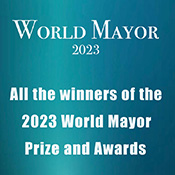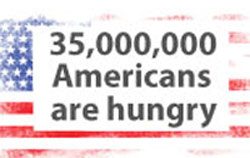
 |
Millions of Americans |
|
FRONT PAGE About us   ON OTHER PAGES 2020 US Census - Counting Americans US mayors caught up in nation's culture war Opinion: Trust and race in America Opinion: Fighting racism in America Hunger in America The guns of America Police killings of Black Americans Post-Covid, American cities strengthen economic equity, resilience and regionalism American policing An American Dream for the 21st century American mayors: Moral values in politics Public health and racism in the US City Equity Offices to counter systematic racism in America List of US City Equity Offices African American Mayors Ending racism in American cities - a conversation with Rochester's (NY) first black mayor The strengths and weaknesses of US cities during a pandemic US local government structures US mayors (2020) US cities and Covid-19: Six pages of research & tables COVID-19 hits African Americans hardest Mass shootings in the USA In the US, cities lead in fighting poverty World's capital cities and their mayors (2020) |
 Food Policy Councils propose Food Policy Councils proposelocal solutions to food inequality By Tony Favro, City Mayors Fellow July 2021: The United States is the richest nation in the world by many measures, yet millions of Americans confront hunger. According to the US Department of Agriculture's Household Food Insecurity in the United States report, more than 35 million people in the United States experienced hunger in 2019. Older cities in the United States also contain thousands of hectares of municipal-owned land where vacant and abandoned homes and other buildings were demolished. American cities have been creating or joining food policy councils to evaluate food system problems, such as hunger, at the local level, and facilitate solutions such as putting vacant urban lands to productive community agricultural uses. There are currently more than 300 food policy councils in the United States. Urban farming replaces abandoned land and buildings The cities of Detroit, Cleveland, and Buffalo are recognized as models of urban agriculture in the United States. In parts of these cities and others, 21st century urban landscapes give way to 19th century rural landscapes. Decades of economic disinvestment and population loss left these cities with vacant and abandoned properties. The cities’ response to disinvestment includes mass demolition. Since 2014, Detroit demolished 20,000 vacant and abandoned buildings; Cleveland and Buffalo, around 10,000 each. Crop fields, greenhouses, community gardens, and pastures now occupy land where many of these buildings once stood. Urban agriculture, in many cases, is intended to fill the void created by the lack of full-service supermarkets in cities. In recent decades, supermarkets followed people and other businesses to the suburbs. Hunger is also a problem in both urban and rural communities. According to an analysis of federal data for the three years before the pandemic (2016-2018), nearly 32 million Americans, including 12.2 million American children, 14.3 million workers (about 10 percent of all employed adults), and 5.3 million Americans ages 60 or older, lived in households with food insecurity, defined as limited or uncertain access to affordable and nutritious food. In 2019, the number rose to 35 million. During the 2020 pandemic year, the number of Americans facing the threat of hunger increased to an estimated 54 million (1). A specialized vocabulary has developed around disinvestment-related hunger and food security in the US. For example, “food deserts” is a term used by the US Department of Agriculture to describe low-income areas with few places where residents can buy healthy food; “food swamps” are areas characterized by an abundance of unhealthy food where nutritious food is hard to find or unaffordable; “food apartheid” refers to unequal access to healthy food resulting from structural economic, racial, or social inequities. Food policy councils are designed to deal with these and other problems. Food Policy Councils fill gaps in local food chains The first food policy council in the US was established in 1982 in the City of Knoxville, Tennessee. Today, there are over 300 food policy councils in the US; a few operate within an entire state, but most are local or regional (2). Food policy councils bring together diverse stakeholders in the food system, such as farmers, distributors, retailers, food service operators, government agencies, and relevant nonprofit community organizations to examine all food-related policies and make recommendations for improving policies, improving coordination between existing programs, and starting new programs. Generally, the councils address gaps in the local food system. For example: • Oakland: California’s Food Policy Council was established in 2008 following a study of Oakland’s food system commissioned by the city’s Mayor’s Office. The Food Policy Council’s activities included conducting a Right to Grow campaign promoting the idea that the growing and selling of food throughout the city is a basic human right. The campaign convinced the city of Oakland to update its zoning laws, which prevented growing food for consumption in certain areas of the city. The updated land use regulations support urban agriculture and increase the access of city residents to healthy locally grown food. • Chicago: Illinois’ Food Policy Action Council, formed in 2002, works with the city to provide technical support to small food businesses. Its initiatives to improve food access in underserved neighborhoods include conducting a food literacy campaign and helping develop compost drop-off sites. In 2020, the Council worked with the South Suburban Mayors and Managers Association to identify vacant and underutilized public land across Chicago and Cook County, analyzing potential sites for urban agriculture based on community food access needs and the economic viability of parcels. • Hartford: Connecticut’s Advisory Commission on Food Policy began operations in 1991 to implement the recommendations of the Mayor’s Task Force on Hunger. Activities of the Commission include working with transit agencies, government, and community residents to connect underserved areas with affordable, full-service grocery stores. The Commission also serves as a supermarket industry watchdog, publishing regular surveys of grocery prices and advocating for fair pricing policies. • Kansas City: Missouri’s Food Policy Coalition, established in 2007, seeks to persuade schools and other government agencies to purchase from local farmers. Other food policy councils are involved in such initiatives as reducing food waste, educating officials and the public, mapping and publicizing local food resources, raising funds, and organizing community gardens and farmers’ markets. Food policy has become an essential element of broader regeneration efforts in many American cities. “We have prioritized efforts to focus on underserved neighborhoods with low healthy food access and to advance initiatives that improve food access along with economic mobility – through living wage jobs, entrepreneurship, business ownership, and new community wealth building tools,” says Denver Mayor Michael Hancock in the 2018 Denver Food Action Plan. In Cleveland, urban agriculture is the basis of neighborhood stabilization through large scale worker-owned cooperative businesses and other green job creators. In 2008, Mayor Frank Jackson gave many of the responsibilities for urban agriculture to the city’s Department of Economic Development. History and politics The earliest food policy councils were established primarily through resolutions of local governments. They were created as advisory bodies to provide non-binding advice to the local government and other stakeholders. In recent years, local activists and organizations began to establish food policy councils as nonprofit organizations or community coalitions. About two-thirds of the food policy councils in the US are organized outside of government, and their recommendations continue to be advisory. An exception is New York City’s Mayor’s Office of Food Policy, which is a full-fledged city agency, perhaps the only municipal department of food in the US. Part of the reason for the shift to non-government organization is because the food/nutrition and sustainable agriculture movements began to focus on community food systems, creating new awareness, new activism, and new leaders outside of government. The administration of President Barack Obama was instrumental in increasing the profile and importance of the food agenda in the United States. The federal government supported policies and programs to coordinate local and regional food systems and provided funding for food system initiatives to both governments and nongovernmental partnerships. On the recommendation of former Chicago Mayor Rahm Emanuel, and with the involvement of former First Lady Michelle Obama, the US Conference of Mayors established a food policy task force in 2013. One of the goals of the taskforce is to grow the movement of food policy and mayors advocating for food policy around the country. The current taskforce co-chairs are Mayor Muriel Bowser of Washington DC and Mayor Brandon Scott, of Baltimore, Maryland. The US Conference of Mayors’ food policy taskforce signed the Milan Urban Food Policy Pact, an agreement by more than 200 cities around the world to exchange ideas and best practices for developing sustainable and affordable food systems with low environmental impact. Federal resources for food systems declined during the Trump administration, and urban revitalization became a lower federal priority. Private organizations began to fill the funding and leadership void. For example, the Bloomberg Philanthropies, an initiative of former New York Mayor Michael Bloomberg, provided grants to 30 organizations in 23 states to create partnerships leading to innovative policies to support public health, especially for low-income communities and communities of color, and to increase the availability of nutritious food and beverages in schools, restaurants, and grocery stores. Upon assuming office, President Biden signed several executive orders, rolled out major legislation including a $1.9 trillion pandemic response bill, and rejoined the Paris Agreement on climate change. Included in these early initiatives are several with positive and meaningful implications for food policy such as expanding the social safety net, increasing the resiliency of the nation’s food supply chains, and supporting small farmers. Biden also appointed Thomas Vilsack, former mayor of Mount Pleasant, Iowa, as Secretary of Agriculture. Vilsack has a long history of support for a safe, sufficient, and nutritious food supply and community-based partnerships. Conclusion Food policy councils are growing in number in the US because they can make a difference. Research conducted by the US Centers for Disease Control and Prevention and 25 state health departments finds that food policy councils can increase access to healthy foods (3). Other studies show similar positive results (4). On the other hand, food policy councils are driven by the necessity of local governments and mayors to deal with the consequences of urban and rural disinvestment and, relatedly, food insecurity. They are more of a band aid than a structural remedy. But, as Mayor Greg Fischer of Louisville, Kentucky says, “Mayors have to get things done, no matter the challenge… the question of how to put food on the table is getting harder to answer for millions of families.” Endnotes All websites accessed May 2021 1. Hunger Free America, U.S. Middle Class Decline Link 2. Johns Hopkins University Center for a Livable Future, Food Policy Council Directory Link 3. US Centers for Disease Control and Prevention, Division of Nutrition, Physical Activity and Obesity State Program Highlights: Food Policy Councils Link 4. Gupta, C., et. al., Food policy councils and local governments: Creating effective collaboration for food systems change, Journal of Agriculture, Food Systems, and Community Development, Volume. 8, Supplement 2, October 2018 Link Schiff, R., The role of food policy councils in developing sustainable food systems. Journal of Hunger and Environmental Nutrition, Volume 3, Issue 2-3, October 2008 Link Selected Resources D. Andreatta. Hungry for Change: Rochester’s new Food Policy Council aims to drain the city’s “food swamp” and end “food apartheid”. City. May 2021 Link C. Gupta. Food policy councils are emerging as a model to address gaps in local policies. UC Division of Agriculture and Natural Resources. 19 February 2019 Link Rural Health Information Hub. Food Policy Councils Link Zaballos, L. Food and Agricultural Policy in Biden’s First 100 Days. 28 April 2021 Link © Copyright: City Mayors Foundation. All rights reserved Follow @City_Mayors |